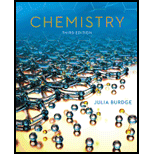
Interpretation:
The preparation of metal chlorides by various methods is to be stated.
Concept introduction:
Metal chlorides are the compounds that are formed by a metal and chlorine. They can be ionic compounds, covalent compounds, or
Metal chlorides are formed by various methods:
A metal chloride can be prepared by a direct reaction of a metal and molecular chloride. This reaction is very exothermic and hence, impractical for use.
Metals react with acids to form salts and release hydrogen gas. The metals that are more reactive than acids replace hydrogen to form salts.
A neutralization reaction involves the reaction of an acid and a base to give salt and water.
The reaction between a metal carbonate andacid results in the formation of a corresponding salt, carbon dioxide, and water.
The reaction that involves the formation of an insoluble salt by the mixing of two soluble salts is known as a precipitation reaction.
Want to see the full answer?
Check out a sample textbook solution
Chapter 24 Solutions
Student Study Guide for Chemistry
- Why are the lanthanoid elements not found in nature in their elemental forms?arrow_forwardNitric acid (HNO3) reacts with iodide ions (I-) to form iodine (I2) and nitrogen oxide (NO) in an acidic aqueous solution. Write the balanced equation for this reaction.arrow_forwardMetal oxides tend to be basic and react with acids True or False?arrow_forward
- The only alkali metal that reacts with oxygen to give a compound with the expected stoichiometry is lithium,which gives Li2O.In contrast,soduim reacts with oxygen to give Na2O2,and the heavier alkali metals form superoxides.Explain the difference in stoichiometries of these productsarrow_forwardIn Ethereum, what is the function of gas?arrow_forwardWhy do Selenium and tellurium occur in rare minerals?arrow_forward
- Explain reaction between SAE 304 stainless steel and isopropanol and why it may cause rust?arrow_forwardPredict the reaction of Cr2+, Fe2+, Cl-, HClO, Zn(s) when blowing air into an acidic aqueous solution.arrow_forwardWhat are the silicate minerals, and enlist the industries using them as raw materials?arrow_forward
- Write the balanced reaction for the synthesis of Al2O3 from its elements?arrow_forward(a) What is the range of oxidation states shown by the ele-ments of Group 5A(15) as you move down the group? (b) How does this range illustrate the general rule for the range of oxida-tion states in groups on the right side of the periodic table?arrow_forwardExplain and elaborate on what the synthesis methods of Cobalt(II) sulphate is and the types of synthesis methods one can fine for CoSO4.7H2Oarrow_forward
 Chemistry: Principles and PracticeChemistryISBN:9780534420123Author:Daniel L. Reger, Scott R. Goode, David W. Ball, Edward MercerPublisher:Cengage Learning
Chemistry: Principles and PracticeChemistryISBN:9780534420123Author:Daniel L. Reger, Scott R. Goode, David W. Ball, Edward MercerPublisher:Cengage Learning Chemistry: The Molecular ScienceChemistryISBN:9781285199047Author:John W. Moore, Conrad L. StanitskiPublisher:Cengage Learning
Chemistry: The Molecular ScienceChemistryISBN:9781285199047Author:John W. Moore, Conrad L. StanitskiPublisher:Cengage Learning General Chemistry - Standalone book (MindTap Cour...ChemistryISBN:9781305580343Author:Steven D. Gammon, Ebbing, Darrell Ebbing, Steven D., Darrell; Gammon, Darrell Ebbing; Steven D. Gammon, Darrell D.; Gammon, Ebbing; Steven D. Gammon; DarrellPublisher:Cengage Learning
General Chemistry - Standalone book (MindTap Cour...ChemistryISBN:9781305580343Author:Steven D. Gammon, Ebbing, Darrell Ebbing, Steven D., Darrell; Gammon, Darrell Ebbing; Steven D. Gammon, Darrell D.; Gammon, Ebbing; Steven D. Gammon; DarrellPublisher:Cengage Learning Chemistry by OpenStax (2015-05-04)ChemistryISBN:9781938168390Author:Klaus Theopold, Richard H Langley, Paul Flowers, William R. Robinson, Mark BlaserPublisher:OpenStax
Chemistry by OpenStax (2015-05-04)ChemistryISBN:9781938168390Author:Klaus Theopold, Richard H Langley, Paul Flowers, William R. Robinson, Mark BlaserPublisher:OpenStax



